IJCRR - 13(17), September, 2021
Pages: 116-121
Date of Publication: 12-Sep-2021
Print Article
Download XML Download PDF
Protein Enrichment of Cassava Pulp by using Saccharomyces Cerevisiae and Candida Utilis as Alternative Feed Resource
Author: Pichad Khejornsart
Category: Healthcare
Abstract:Introduction: Cassava (Manihot esculentaCrantz) pulp was increasingly and potential as environmental pollution, this study aimed to determine the optimal condition for increasing protein content of cassava pulp by microbial fermentation under the various condition. Methods: Cassava pulp were fermented with each pure strain of S. cerevisiae or C. Utilis using urea as a Nitrogen (N) source (0, 2, 4, and 8%) for 8 days. Reducing sugar, crude protein, NPN and cell number were measured daily. Results: It was found that significant increase (p< 0.05) in the reducing sugar, crude protein and yeast cell of fermented cassava pulp compared to unfermented. C. Utilis fermented cassava pulp increased higher protein content and reduced NPN level compared to S. cerevisiae. Protein and cell number can be increased from 2.59% and 0.59 x 109 cell/g (unfermented) to 33.34% and 5.13 x 109 cell/g, respectively, of which the optimum condition for producing the maximum cell count of C. Utilis was 4% urea and fermented for 4 days. Conclusion: It is suggested that the use of cassava pulp fermented with C. Utilis at 4% urea for 4 days could be optimal to improve total protein by up to 30.55 and 16.13% of true protein which would subsequently as alternative feedstuff for animals.
Keywords: Cassava pulp, S. cerevisiae, C. Utilis, Single-cell protein, Feed resources, Fermentation
Full Text:
Introduction
The substantial increase in demand for livestock products in developing countries has resulted in a consequent increase in the production and supply of animal feed. The exploitation of large amounts of agro-industrial waste, such as cassava, is of particular relevance. The cassava plant is cultivated throughout the tropics because of its roots as an important source of carbohydrates. Cassava pulp is a high moist attributed largely to the manufacture of cassava starch and constitutes approximately 10-15% of the original root weight. Thai cassava starch factories were increasingly producing more than 4 million tons per year. Cassava pulp, which is mainly composed of 70% starch, is a valuable resource to be used as feed for livestock. Cassava pulp, however, is slightly low in protein and high in fibre content, restricting its use in animals. There has been reported that dried cassava pulp can be used in broiler diets, with higher levels of inclusion resulting in lower growth performance and digestibility of nutrients.1 It is also noted that the significant disadvantage of the use of cassava root meal in animal feed is due to its low protein content and the inaccessibility of essential amino acids.2If this by-product is fermented with microorganisms to improve its nutritious value before being included in livestock diets, it will also be more beneficial. By raising the protein content of cassava pulp by micro-organism fermentation, an increase in the feed value of cassava pulp could be accomplished. The low protein content of cassava pulp (less than 3% in DM) does not constitute a limitation for cattle, as the use of non-protein nitrogen (NPN) in the form of urea could be possible. However, for monogastric animals such as pigs, an additional supply of true protein is required. The protein content of cassava fermentation with A. niger could increase from 4.4-12.2 per cent.3 In addition, microorganism cultivation, such as A. niger, A.oryzae, S. cerevisiae, C. Utilis and C. tropicalis have also been widely reported in previous research on low protein content feedstuffs.4-8However, the dependability of fermentation can be attributed to variations in microorganism, cassava pulp waste condition and technique, especially true protein content. Therefore, this study was to confirm the optimal conditions for improving the protein content of cassava pulp through S. cerevisiae and C.utilis by using fermentation at different concentrations of urea.
Materials and Methods
Cultivation of microorganism starter
This research used fresh cassava pulp obtained from Premier Quality Starch (2012) Co., Ltd, Sakon Nakhon, Thailand.Microorganisms and preparation of inoculum: In this study, three strains of microorganisms were used: S. cerevisiae (5051) and C. Utilis (5046), collected from the Thai Institute of Scientific and Technical Research (TISTR).S.cerevisiae and C. Utilis were cultivated on Yeast-Malt-Agar (YMA). Batch cultures have been agitated on reciprocal shakers at 200 rpm at 30 °C for 1 day and held at 4 °C. Until substrate inoculation with microorganisms. The suspension was centrifuged at 3000 rpm at 4 °C for 15 minutes and the deposit was washed twice at 0.85 % NaCl. The resulting cells were suspended with 0.85 per cent NaCl to reach an average concentration of 108 cells/mL. To achieve an average concentration of 108 cells/mL, the resulting cells were suspended with 0.85 % NaCl.
Procedure of fermentation
The optimal condition for improving the nutritional composition of cassava pulp by fermentation processes was studied using three variables(microorganism, concentration of urea and time of fermentation). Approximately 50 g of fresh cassava pulp was placed into a 250 mL Erlenmeyer flask with triplicates and was autoclaved for 15 min at 121 °C. At various amounts nitrogen (urea)was applied to each flask.2% of suspension (by 108cell/mL) was immersed in the substrate. Then properly blended and coated with aluminium foil until allowing for 8 days to ferment at 30 °C. The ingredients for fermentation were collected every 2 days (0,2,4,6 and 8 days) of fermentation and consequently for chemical composition.
Sample analysis
After fermentation, the samples (fermentation products) were collected from the Erlenmeyer flask, cut into similar size particles. Then, 10 g of samples were dissolved in a 250 mL ?ask with 90 mL of sterile saline water (0.9%). The series dilution (105 to 107) was performed for total cell count by using a microscope. Approximately 10 mL of sample was centrifuged at 2000 ×g for 10 min. The supernatants were used for glucose concentration measurement. The glucose concentration was measured by a colourimetric method using the dinitrosalicylic acid (DNS) reagent and a spectrophotometer at a wavelength of 540 nm.9Total nitrogen and moisture contents of samples were determined by standard procedure.10Non-protein nitrogen was measured precipitated from the diluted sample with trichloroacetic acid, and true protein was measured using the Kjeldahl method.11
Statistical analysis
Statistical analysis was carried out using factorial arrangement in CRD according to the GLM procedure of SAS.12Analysis of variance (ANOVA) was performed and the significant differences between treatment means were determined by Duncan New Multiple Range Test.
Results
Production of reducing sugar and yeast cell biomass
The results of this study show that, after fermentation with C. Utilis at urea level, the reducing sugar content of cassava pulp reached a maximum of 235.3 mg/g for 6 days and subsequently tended to decrease at the end of the fermentation period (Fig. 1). While the reducing sugar of S. cerevisiae-fermented cassava pulp remained lower at both urea levels and fermentation times (Fig. 2).
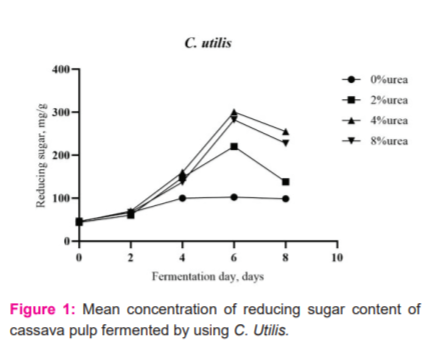
Production of protein
Cassava pulp fermentation protein and true protein derived from S. cerevisiae and C. Utilis showed that urea level and fermentation time with optimal condition exhibited significant influent concerning protein content (P = 0.023). Chemical analysis findings found that the protein and true protein content of fermented cassava pulp are higher than that of unfermented cassava pulp and true protein was highest in cassava pulp fermentation by C. Utilis with 4% urea at 4 days. This phenomenon was due to the influence of the mechanism of microbial cell growth and the N source of urea.
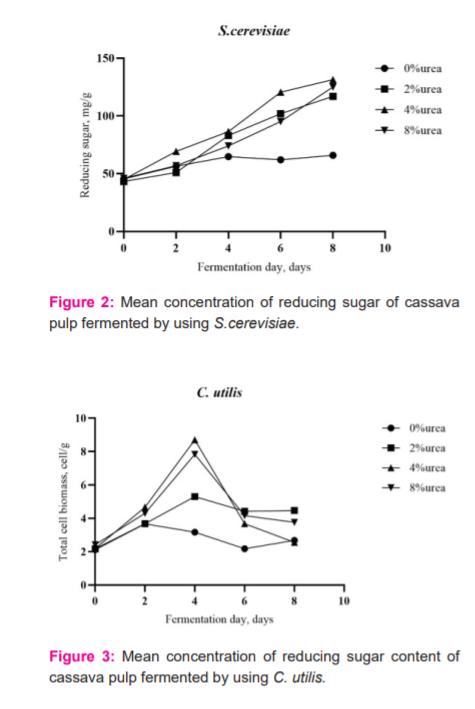

Production of protein
Cassava pulp fermentation protein and true protein derived from S. cerevisiae and C. Utilis showed that urea level and fermentation time with optimal condition exhibited significant influent concerning protein content (P = 0.023). Chemical analysis findings found that the protein and true protein content of fermented cassava pulp are higher than that of unfermented cassava pulp and true protein was highest in cassava pulp fermentation by C. Utilis with 4% urea at 4 days. This phenomenon was due to the influence of the mechanism of microbial cell growth and the N source of urea.
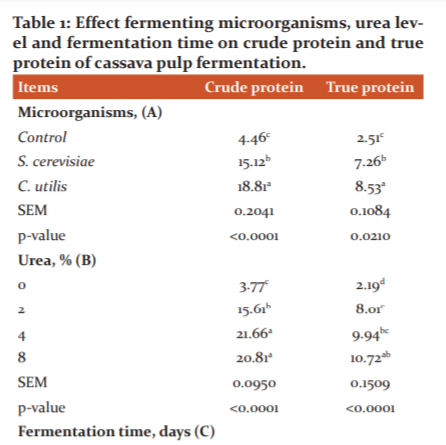
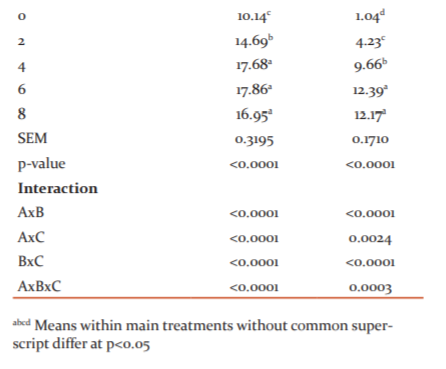
Fermentation with C. Utilis resulted in a higher rate of conversion of crude to true protein than fermentation with S. cerevisiae, with intermediate results from urea and fermentation period (Table 1.).Cassava pulp fermented for each urea level for 8 days shows an improvement in crude protein and true protein content from 3.77 to 21.66 and 2.19 to 10.72, respectively, while fermentation time increase from 0 to 8 days, crude protein increased from 10.14 to 17.86 and true protein increased from 1.04 to 12.39, respectively.
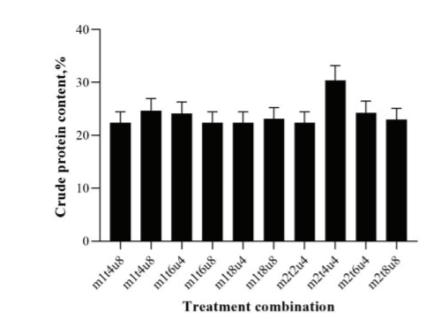
Fig. 5: Crude protein contentof cassava pulp fermented usingS. cerevisiae andC.utilis by various urea concentration during 8 days of fermentation (m1 = S. cerevisiae,m2 = C.utilis; t0 = day 0, t2 = day 2, t4 = day 4, t8 = day 8; u0 = 0%urea, u2 = 2% urea, u4 = 4%urea and u8 = 8% urea)
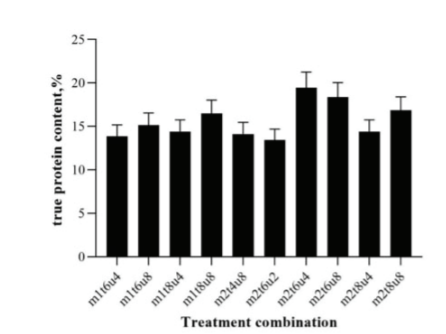
Fig. 6: True protein content of cassava pulp fermented usingS. cerevisiae andC.utilis by various urea concentration during 8 days of fermentation (m1 = S.cerevisiae, m2 = C.utilis; t0 = day 0, t2 = day 2, t4 = day 4, t8 = day 8; u0 = 0%urea, u2 = 2% urea, u4 = 4%urea and u8 = 8% urea)
From the combinations of effects of independent variables on the crude protein and true protein content(Fig.5), it can be noted that the maximized protein production(33.15%)was achieved at 4% urea and 4 days of fermentation by using C.Utilis. An increase of 30.41% was noted in comparison with non-fermented cassava pulp.
Discussion
Production of reducing sugar and yeast cell biomass
To the results of this study, cassava pulp fermentation by C. Utilis at 4% of urea, the reducing sugar content was highest. While the reducing sugar of S. cerevisiae-fermented cassava pulp remained lower at both urea levels and fermentation times. In general, microorganisms have a wide capacity to produce the enzyme for starch degradation into sugar and glucose. It has recently been reported that yeast produces enzymatic activity, which is an enzyme involved required for polysaccharides decarboxylation into smaller sugars.C. Utilis can generate enzymes, in particular cellulase and amylase, to hydrolysate glucosidic bonds in polysaccharides may be seen with the highest reducing sugar content of cassava pulp fermentation with C. utilis.13The cell maximal amount obtained is similar for Saccharomyces species (8.92 g/L)13and also obtained 10.83 and 8.29 g/L, respectively from C. Tropicalis and C. Utilis NOY1.14This could be useful to food and agro-based industries for the development of value-added goods, waste disposal, and valorization, as stated in the finding of C. Utilis yeast cultivation on cassava peel showed high significance in growth rate and cell concentration.15
Production of protein
The protein content in this study was obtained rage from 8.76 to 33.55 % of DM and it was higher than the results of the previous report.16 It is also existing research on cassava pulp fermentation with microorganisms that is still inaccessible, whereas a great deal of information on fermented cassava has been widely reported. There has been reported that C. Utilis-fermented cassava root can increase crude protein by up to 18.3%.5 In this study, the maximum amount of crude protein derived from S. cerevisiae and C. Utilis was 24.67% fermented for 4 days at 8% urea and30.34% fermented for 4 days at 4% urea, respectively. However, a portion of N from urea that is known to be a non-protein N and not useful for non-ruminant animals was included in this protein enhancement. In addition, it has also been reported that true protein is more effective than crude protein for animal production. There have been found after 48 hours of fermentation, the mean crude protein content of fermented cassava increased from 0.74 to 4.58 per cent.6, 17-18Considering that most observations show that the highest degree of conversion of added NPN sources to true protein is on the order of 70-80%, the logical implication is that residual NPN is the element causing lower intake and hence growth rate.19
Several factors can influence microbial growth and product formation during the fermentation process. The composition of the substrate (carbon and nitrogen sources), microbial capacity, and degree of process optimization all may contribute to increasing the supply of reducing sugar to yeast, thus enhancing the efficiency of the process. However, protein production was influenced by the time of cultivation and concentration of substrate.20 It can be established that the optimal conditions for the growth of S. cerevisiae and C. Utilis in cassava pulp to produce the maximum biomass is 8% fermented urea for 4 days and 4% fermented urea for 4 days, respectively.S. cerevisiae and C. Utilis can produce protein and true protein from 2.59 vs. 0.89% (unfermented) to 22.67 vs. 15.15 and 30.34 vs. 19.46%, respectively, under these circumstances. The treatment combination found significantly different (P<0.0001) among interaction between microorganism, fermentation day and urea level (Table 1). It is laborious to show all the interaction effects, there were represent only the top ten of the best results performed by the fermentation process of crude protein and true protein (Fig.5 and Fig. 6). The interaction of more than one did not show any significant difference. As a result, using microbes to manage environmental emissions is an exciting technology, and microbes may also serve as a platform for an improved bioremediation process for a variety of contaminants.21-22
Conclusion
The significant influent of dependent variables (microbial, urea and fermentation time) on fermentation quality has been noted. It is suggested that the use of cassava pulp fermented with C. Utilis with 4% urea for 4 days could increase crude protein by up to 30.34%, increases the amount of reducing sugar and true protein content which would also provide reasonable feedstuffs for livestock and also be potential to reduce the pollution from agro-industrial by-products. However, the digestibility and performance of animals could be further evaluated.
Acknowledgement
The authors would like to express sincere thanks and appreciation to the Department of Agricultural and Resources, Faculty of Natural Resources and Agro-Industry, Kasetsart University, Chalermphrakiat Sakon Nakhon Province Campus, Thailand for providing research financial and facilities supports.
Source of Funding
No special financial support is needed.
Conflict of Interest
The author declares that there are no conflicts of interest.
Authors’ Contribution:
The author made considerable contributions to the conception and design, data collection and evaluation of the data and was responsible for all aspects of the work.
References:
-
Khempaka S, Molee W, Guillaume M. Dried cassava pulp as an alternative feedstuff for broilers: Effect on growth performance, carcass traits, digestive organs and nutrient digestibility. J Applied Poult Res. 2009; 18: 487-493.
-
Chauynarong N, Elangovan AV, Iji PA. The potential of cassava products in diets for poultry. World's Poult Sci J 2009; 65: 23-36.
-
Oboh G. Nutrient enrichment of cassava peels using a mixed culture of Saccharomyces cerevisae and Lactobacillus sp. solid media fermentation techniques. Electron J Biotechnol. 2006; 9: 46-49.
-
Oboh G, Akindahunsi AA, Oshodi AA. Nutrient and anti-nutrient contents of Aspergillus niger-fermented cassava products (flour and gari). J Food Comp Anal. 2002; 15: 617-622.
-
Chumkhunthod P, Rodtong S, Teaumroong N, Boonkerd N. Bioconversion of cassava roots to high protein product for animal feed. Thai J Biotechnol. 2001; 3: 17-25.
-
Boonop K, Wanapat M, Nontaso N, Wanapat S. Enriching nutritive value of cassava root by yeast fermentation. Sci Agric. 2009; 66(5): 629-633.
-
Sokchea H, Thi Hang P, Dinh Phung L, Duc Ngoan L, Thu Hong TT, Borin K et al. Effect of Time, Urea and Molasses Concentration on Saccharomyces cerevisiae Biomass Production. J Vet Ani Res. 2018; 1: 104.
-
Hang DT, Chau HLQ, Hang LTT, Preston TR. Protein-enrichment of cassava pulp as feed for growing pigs. Livest Res Rural Dev. 2019; 31(5).
-
Miller GL. Use of dinitro salicylic acid reagent for determination of reducing sugar. Anal Chem. 1959; 31: 426-428.
-
AOAC. Official Methods of Analysis, 19th ed.; Association of Official Analytical Chemists: Gaithersburg, MD, USA, 2012.
-
Licitra G, Hernandez T, Van Soest P. Standardization of procedures for nitrogen fractionation of ruminant feeds. Ani Feed Sci and Tech. 1996; 57: 347-358.
-
SAS. User’s Guide: Statistic, Version 6.12thed.; SAS Inst. Inc.: Cary, NC, USA, 1998.
-
Somda MK, Savadogo A, Ouattara CAT, Ouattara AS, Traoré AS.Production of alcohol from mango (Mangifera Indica L.) using strains of Saccharomyces and Schizosaccharomyces genera isolated from wasted mangos in Burkina Faso. Biosci Biotech Res Asia. 2010; 7(2): 529-536.
-
Gao Y, Li D, Liu Y.Production of single-cell protein from soy molasses using Candida tropicalis. Ann Microbiol. 2012;62(3): 1165-1172.
-
Ezekiel O, Aworh O. Simultaneous saccharification and cultivation of Candida Utilis on cassava peel. Innov Food Sci Emer Tech. 2018; 49: 184-191.
-
Thongkratok R, Khempaka S, Molee W. Protein enrichment of cassava pulp using microorganisms fermentation technique for use as an alternative animal feedstuff. J Anim Vet Adv. 2010; 9 (22): 2859-2862.
-
Tefera T, Ameha K, Bruhtesfa A. Cassava based food: Microbial fermentation by single starter culture towards cyanide reduction, protein enrichment, and palatability. Inter Food Res. 2014; 21(5):1751-1756.
-
Sengxayalth P and Preston TR. Fermentation of cassava (Manihot esculenta Crantz) pulp with yeast, urea and diammonium phosphate (DAP). Livest Res Rural Dev. 2017; 29(9).
-
Bayitse R, Hou X, Laryea G and Bjerre AB. Protein enrichment of cassava residue using Trichoderma pseudokoningii (ATCC 26801). AMB Express. 2015; 5(80); 1-6.
-
Coman G, Leustean I, Georgescu L, Bahrim G.Optimization of protein production by Geotrichum candidum miug 2.15 by cultivation on paper residues, using response surface methodology. BioResources 2012; 7(4): 5290-5303.
-
Kour D, Kaur T, Devi R, Yadav A, Singh M, Joshi D, Singh J, Suyal DC, Kumar A, Rajput VD, Yadav AN, Singh K, Singh J, Sayyed RZ, Arora NK, Saxena AK et al. Beneficial microbiomes for bioremediation of diverse contaminated environments for environmental sustainability: present status and future challenges. Environ Sci Pollut Res 2021.
-
Salvia HM, Yadav GD. Process intensification using immobilized enzymes for the development of white biotechnology. Catal Sci Technol. 2021; 11: 1994-2020.
|






 This work is licensed under a Creative Commons Attribution-NonCommercial 4.0 International License
This work is licensed under a Creative Commons Attribution-NonCommercial 4.0 International License